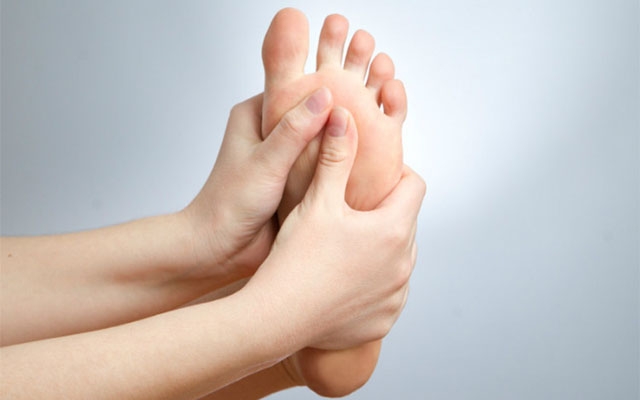Your Involuntary toe movement images are ready in this website. Involuntary toe movement are a topic that is being searched for and liked by netizens today. You can Find and Download the Involuntary toe movement files here. Find and Download all free photos and vectors.
If you’re looking for involuntary toe movement pictures information connected with to the involuntary toe movement topic, you have come to the ideal site. Our site frequently provides you with suggestions for refferencing the maximum quality video and image content, please kindly hunt and find more informative video content and graphics that match your interests.
Involuntary Toe Movement. Described as an abnormal involuntary movement disorder of the hands or feet and is comparable to dance-like movements. Progressive may appear at anytime of life but most commonly 70 years. Curled clenched toes or a painful cramped foot are telltale signs of dystonia. Tensing up the toes anxiety habit Improper footwear especially a tight toe box.
 Painful Legs And Moving Toes Syndrome Bmj Case Reports From casereports.bmj.com
Painful Legs And Moving Toes Syndrome Bmj Case Reports From casereports.bmj.com
Tremor chorea dystonia and myoclonus are examples of types of dyskinesia which have different mechanisms and modalities of treatment. First described in 1971 by Spillane et al1 painful legs and moving toes PLMT is a syndrome consisting of pain in lower legs with involuntary movements of the toes or feet. Abnormal involuntary movements AIMs are also known as dyskinesias. Causes of Toe Twitching. This can cause the. Pressure on a nerve shoes foot position while seated or lying down Anxiety not necessarily about whats causing your toes to twitch but anything that can cause apprehension Insufficient calcium and magnesium intake.
An involuntary movement occurs when you move your body in an uncontrollable and unintended way.
The cause of this condition is unknown. Movements affect toes more than the foot and often appear as a continual wriggling and writhing motion. Uncontrolled muscle cramps and spasms. Abnormal involuntary movements AIMs are also known as dyskinesias. The syndrome of painful legs and moving toes consists of continuous or semicontinuous involuntary writhing movements of the toes associated with pain in the affected extremity. Tensing up the toes anxiety habit Improper footwear especially a tight toe box.
 Source: pinterest.com
Source: pinterest.com
Shaking tremors uncontrolled blinking. Classically affects head andor speech. Involuntary means that you have no control over said movements and they sometimes can be worsened by certain activities. The syndrome of painful legs and moving toes consists of continuous or semicontinuous involuntary writhing movements of the toes associated with pain in the affected extremity. Curled clenched toes or a painful cramped foot are telltale signs of dystonia.
 Source: ar.pinterest.com
Source: ar.pinterest.com
Progressive may appear at anytime of life but most commonly 70 years. Symptoms of dystonia include. Painful legs and moving toes syndrome PLMT is rare and characterized by involuntary and irregular movements of toes and variable pain of the foot and leg. Most common involuntary movement disorder typified by a rapid postural tremor most often of the upper extremities. Movements affect toes more than the foot and often appear as a continual wriggling and writhing motion.
 Source: geelongmedicalgroup.com.au
Source: geelongmedicalgroup.com.au
There are several varieties of dyskinesia which have different clinical appearances underlying causes and treatments. Parts of your body twisting into unusual positions such as your neck being twisted to the side or your feet turning inwards. Curled clenched toes or a painful cramped foot are telltale signs of dystonia. This movement may be continuous or occasionally. Painful legs and moving toes syndrome PLMT is rare and characterized by involuntary and irregular movements of toes and variable pain of the foot and leg.
 Source: practicalneurology.com
Source: practicalneurology.com
Described as an abnormal involuntary movement disorder of the hands or feet and is comparable to dance-like movements. For example dystonia is a common early symptom of young-onset Parkinsons. Involuntary leg movement is most commonly seen at night and would be called restless leg syndrome. The cause of this condition is unknown. DearCustomer HelloThe posibilities are degenerative akithesiaPainful leg and moving toes Syndrome a rare disorder marked by pain and movement of legs and toesthe cause is unknownParoxysmal dystonia-Paroxymal kinesigenic dyskinesia and Paroxymal NonKinesigenic Dyskinesiaare rare forms of slow chorea and which may affect the patient from a few minutes to a few hoursPeriodic Limb Movement.
 Source: youtube.com
Source: youtube.com
Uncontrolled muscle cramps and spasms. The syndrome of painful legs and moving toes consists of continuous or semicontinuous involuntary writhing movements of the toes associated with pain in the affected extremity. Described as an abnormal involuntary movement disorder of the hands or feet and is comparable to dance-like movements. The urge to move is the part that you HAVE to have. An involuntary movement occurs when you move your body in an uncontrollable and unintended way.
 Source: healthline.com
Source: healthline.com
An involuntary movement occurs when you move your body in an uncontrollable and unintended way. First described in 1971 by Spillane et al1 painful legs and moving toes PLMT is a syndrome consisting of pain in lower legs with involuntary movements of the toes or feet. Mainly a postural tremor but if worsened will occur at rest. Tremor chorea dystonia and myoclonus are examples of types of dyskinesia which have different mechanisms and modalities of treatment. Joint inflammation or injury can put pressure on or damage motor nerves that deliver signals to your toe muscles to move.
 Source: ro.pinterest.com
Source: ro.pinterest.com
Dystonia is a sustained or repetitive muscle twisting spasm or cramp that can occur at different times of day and in different stages of Parkinsons disease PD. Symptoms of dystonia include. Mainly a postural tremor but if worsened will occur at rest. This can cause the. The cause of this condition is unknown.
 Source: pinterest.com
Source: pinterest.com
A urge you cant resist its a voluntary movement. Symptoms of dystonia include. Painful legs and moving toes syndrome PLMT is rare and characterized by involuntary and irregular movements of toes and variable pain of the foot and leg. For example dystonia is a common early symptom of young-onset Parkinsons. Involuntary movements are commonly called tics tremors or dystonia.
 Source: pinterest.com
Source: pinterest.com
Dystonia is a sustained or repetitive muscle twisting spasm or cramp that can occur at different times of day and in different stages of Parkinsons disease PD. The syndrome of painful legs and moving toes consists of continuous or semicontinuous involuntary writhing movements of the toes associated with pain in the affected extremity. This movement may be continuous or occasionally. Pain varies from moderate discomfort to diffuse and deep and usually precedes movements by days to years. Involuntary leg movement is most commonly seen at night and would be called restless leg syndrome.
 Source: casereports.bmj.com
Source: casereports.bmj.com
You have to have all the criteria for RLS to be diagnosed with having it. The cause of this condition is unknown. This movement may be continuous or occasionally. For example dystonia is a common early symptom of young-onset Parkinsons. Involuntary movements are commonly called tics tremors or dystonia.
 Source: pinterest.com
Source: pinterest.com
This movement may be continuous or occasionally. Mainly a postural tremor but if worsened will occur at rest. The syndrome of painful legs and moving toes consists of continuous or semicontinuous involuntary writhing movements of the toes associated with pain in the affected extremity. The symptoms may be continuous or come and go. Tremor chorea dystonia and myoclonus are examples of types of dyskinesia which have different mechanisms and modalities of treatment.
 Source: footprints.aetrex.com
Source: footprints.aetrex.com
Classically affects head andor speech. Symptoms of dystonia include. Causes of Toe Twitching. The syndrome of painful legs and moving toes consists of continuous or semicontinuous involuntary writhing movements of the toes associated with pain in the affected extremity. This movement may be continuous or occasionally.
 Source: pinterest.com
Source: pinterest.com
Classically affects head andor speech. If you dont have that urge then its not RLS. Involuntary movements are commonly called tics tremors or dystonia. The syndrome of painful legs and moving toes consists of continuous or semicontinuous involuntary writhing movements of the toes associated with pain in the affected extremity. Tremor chorea dystonia and myoclonus are examples of types of dyskinesia which have different mechanisms and modalities of treatment.
 Source: pinterest.com
Source: pinterest.com
Involuntary leg movement is most commonly seen at night and would be called restless leg syndrome. First described in 1971 by Spillane et al1 painful legs and moving toes PLMT is a syndrome consisting of pain in lower legs with involuntary movements of the toes or feet. These movements can be anything from quick jerking tics to longer tremors and seizures. Tensing up the toes anxiety habit Improper footwear especially a tight toe box. Classically affects head andor speech.
 Source: healthywomen.org
Source: healthywomen.org
The cause of this condition is unknown. Movements affect toes more than the foot and often appear as a continual wriggling and writhing motion. For example dystonia is a common early symptom of young-onset Parkinsons. Causes of Toe Twitching. Joint inflammation or injury can put pressure on or damage motor nerves that deliver signals to your toe muscles to move.
 Source: id.pinterest.com
Source: id.pinterest.com
Pressure on a nerve shoes foot position while seated or lying down Anxiety not necessarily about whats causing your toes to twitch but anything that can cause apprehension Insufficient calcium and magnesium intake. Pain varies from moderate discomfort to diffuse and deep and usually precedes movements by days to years. Abnormal involuntary movements AIMs are also known as dyskinesias. The syndrome of painful legs and moving toes consists of continuous or semicontinuous involuntary writhing movements of the toes associated with pain in the affected extremity. Shaking tremors uncontrolled blinking.
 Source: casereports.bmj.com
Source: casereports.bmj.com
Crackingtonhaven in reply to Hidden 3 years ago. There are several varieties of dyskinesia which have different clinical appearances underlying causes and treatments. If you dont have that urge then its not RLS. Described as an abnormal involuntary movement disorder of the hands or feet and is comparable to dance-like movements. Uncontrolled muscle cramps and spasms.
 Source: pinterest.com
Source: pinterest.com
The cause of this condition is unknown. Pain varies from moderate discomfort to diffuse and deep and usually precedes movements by days to years. Described as an abnormal involuntary movement disorder of the hands or feet and is comparable to dance-like movements. Abnormal involuntary movements AIMs are also known as dyskinesias. Shaking tremors uncontrolled blinking.
This site is an open community for users to share their favorite wallpapers on the internet, all images or pictures in this website are for personal wallpaper use only, it is stricly prohibited to use this wallpaper for commercial purposes, if you are the author and find this image is shared without your permission, please kindly raise a DMCA report to Us.
If you find this site beneficial, please support us by sharing this posts to your favorite social media accounts like Facebook, Instagram and so on or you can also bookmark this blog page with the title involuntary toe movement by using Ctrl + D for devices a laptop with a Windows operating system or Command + D for laptops with an Apple operating system. If you use a smartphone, you can also use the drawer menu of the browser you are using. Whether it’s a Windows, Mac, iOS or Android operating system, you will still be able to bookmark this website.





